Invasive Exotic Plant Species in Cutler Bay
Summary and list of prevalent invasive exotic plant species in Cutler Bay
Invasive exotic plant species pose a very serious threat to ecosystem structures and are one of the biggest threats to biodiversity, second to habitat loss.
In June of 2020, the Town of Cutler Bay Council adopted Resolution 20-30 in order to remove Prevalent Invasive Exotic Plant Species from Town owned properties and rights-of-way, eliminate saplings and sprouts; and create public awareness of the environmental harm by these species, if not managed. This resolution listed six of the most prevalent invasive exotic plant species in Town that have an extraordinary need to be removed.
The list of plants was created with the aid of the Florida Exotic Pest Plant Council and local experts familiar with the Cutler Bay community. They are listed below (scroll down for images and additional information):
- Brazilian jasmine (Jasminum fluminense)
- Brazilian pepper (Schinus terebinthifolius)
- Burmareed (Neyraudia reynaudiana)
- Earleaf acacia or Sickle-leaf acacia (Acacia auriculiformis)
- Elephant grass or Napier grass (Pennisetium purpureum)
- Lead tree (Leucaena leucocephala)
What is an invasive plant?
According to the Florida Exotic Pest Plant Council, invasive plants are non-native plants (also referred to as exotic or alien) that have been introduced to an area outside of their range of natural dispersal, either purposefully or accidentally. Their introduction causes or is likely to cause economic or environmental harm or harm to plant, animal or human health. Some of their negative ecological impacts include:
- Compete with native plants for resources
- Alter fire patterns
- Alter hydrology
- Are not usually a preferred food source for native species
- Alter habitat composition
- Reduce biodiversity
- Shade out native species
- Can create monocultures
- Increase erosion
According to the Florida Department of Agriculture and Consumer Services, there are many reasons to be concerned about the expanding problem of invasive species. For example, approximately 46 percent of the Federally listed threatened and endangered species in the United States are imperiled in part due to impacts of invasive species. Economists have estimated that across the globe, $3-5 trillion may be lost annually to the impacts and management of invasive species—this figure includes impacts by introduced plants and animals, diseases, agricultural weeds and others.
Where can I learn more about invasive exotic plant species?
To learn more about invasive exotic plant species, check out the links below:
Where can I learn about planting the right plants?
Whether you are looking to beautify your home or business through landscaping, remove and replace an invasive species, or just add more greenery to your property, make sure you are putting the right plant in the right place.
Select Florida-Friendly plants and turfgrass that match a site’s soil, light, water, and climatic conditions. Buy quality plants that welcome wildlife, consider mature plant size when you make your purchase, and aim for a diversity of trees, shrubs, and groundcovers. Once these plants are established, they’ll require minimal amounts of supplemental water, fertilizer, or pesticides, saving you time and money. Be sure to check out some of the resources below:
- Florida-Friendly Landscaping™ Program
- FFL Plant Guide
- Ask an expert! Click here to send your questions about Florida-Friendly Landscaping™ to a UF/IFAS Extension agent or other FFL expert.
Where can I learn about invasive animal species?
It's important to note that there are also many invasive animal species that cause great damage to a community. Some of the common offenders of South Florida include the Burmese Python and Green Iguana, to name a few. Learn more about invasive animal species and what to do if you spot one through the link below:
Learn more about the six most prevalent invasive exotic plant species in Cutler Bay
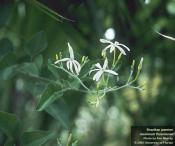
Brazilian jasmine (Jasminum fluminense)
Description: Evergreen, climbing, woody vine, with young stems densely hairy and mature stems glabrous.
Leaves: Opposite, trifoliolate; leaf and leaflets stalked; terminal leaflet larger, to 7 cm (4 in) long with a stalk to 5 cm (2 in) long; leaflets broadly ovate, pubescent above and below with pointed tips.
Impacts: An aggressive, troublesome, difficult-to-control weed; can climb high into the tree canopy of mature forests, completely enshrouding native vegetation and reducing native plant diversity. Has vigorously invaded intact, undisturbed hardwood forests in south Florida. FLEPPC Category I
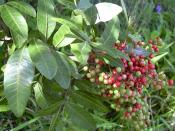
Brazilian pepper (Schinus terebinthifolius)
Description: Brazilian peppertree is a shrub or small tree that reaches over 30 feet in height, typically with a short trunk hidden in a thicket of branches. Some trees can live over 30 years. The leaves are alternately arranged with 1-2 inch long, elliptic, and finely toothed leaflets. The leaves are also reddish, often possessing a reddish mid-rib. The flower clusters are white and 2-3 inches long with male and female flowers that look very similar. The glossy fruits are borne in clusters that are initially green, becoming bright red when ripe. Seeds are dark brown and 0.3 mm in diameter. Flowering occurs from September through November and fruits are usually mature by December.
Impacts: This shrub/tree is one of the most aggressive and wide-spread of the invasive non-indigenous exotic pest plants in the State of Florida. There are over 700,000 acres in Florida infested with Brazilian peppertree. Brazilian peppertree produces a dense canopy that shades out all other plants and provides a very poor habitat for native species. This species invades aquatic as well as terrestrial habitats, greatly reducing the quality of native biotic communities in the state.
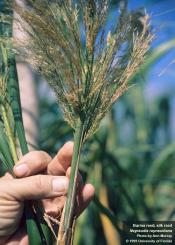
Burmareed (Neyraudia reynaudiana)
Description: Introduced as an ornamental, this new invasive plant is common in south Florida. It can occur in large stands and may easily be mistaken for the native common reed, Phragmites australis. The easiest way to tell the two is that Neyraudiadoes not have a ring of hairs encircling the stem just below the inflorescence, whereas Phragmites does. It is a robust, reed-like perennial to 3 m (10 ft) tall, forming clumps from short, coarse rhizomes. Stems often branched and filled with soft pith.
Impacts: Able to colonize marginal and undisturbed habitats once established in an area. Well established in the globally rare pine rockland habitats of Dade County and viewed as a threat to rare species there, especially since its high flammability promotes frequent fires, enhancing its spread.
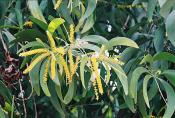
Earleaf acacia or Sickle-leaf acacia (Acacia auriculiformis)
Description: Earleaf acacia was introduced into Florida in 1932 for use as an ornamental tree. It is an evergreen, unarmed tree to 15m (50 ft) tall, with compact spread, often multi-stemmed; young growth glaucous. Its leaves are alternate, simple, reduced to flattened blade-like phyllodes slightly curved, 11–20 cm (5–8 in) long, with 3–7 main parallel veins and a marginal gland near the base; surfaces dark green.
Impacts: This fast-growing invasive tree has invaded pinelands, scrub, and hammocks in south Florida. Earleaf acacia displaces native vegetation and can shade out rare plants. Each mature tree can produce up to 47,000 seeds per year.
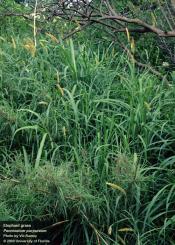
Elephant grass or Napier grass (Pennisetum purpureum)
Description: Napier grass is not native to Florida. It is also known as elephant grass. There are more than 100 species of Pennisetum, some of which are cultivated for grain. Napier grass was introduced to Florida as a forage crop. It is found in swamps and bottomlands and often infests canals, ditches, and irrigated areas of southern Florida.
Napier grass is a large perennial grass with erect stems that grow to 15 feet tall. The leaves are flat and strap-like, up to an inch-and-a-half wide, and several feet long. They have fine-toothed margins, and sparse hairs on the leaf surface. The ligule is composed of long hairs. The inflorescence of napier grass is a cylindrical spike at the top of the stem. It is greenish-tan, 5 to 12 inches long, and about an inch in diameter. The spike is densely packed with flowering spikelets. Many of the spikelets have very long bristles. Napier grass is a very large grass that grows to 15 feet tall. Its leaves are flat and strap-like, and have fine-toothed margins and sparse hairs. The cylindrical flower spike is at the top of the stem and has numerous long bristles.
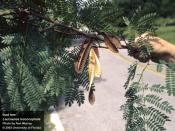
Lead tree (Leucaena leucocephala)
Description: Introduced as an ornamental, this new invasive plant is common in south Florida. It can occur in large stands and may easily be mistaken for the native common reed, Phragmites australis. The easiest way to tell the two is that Neyraudiadoes not have a ring of hairs encircling the stem just below the inflorescence, whereas Phragmites does.
Impacts: In areas where lead tree is considered an invasive weed, it will forms dense thickets and displaces the native vegetation. Disturbed, cleared areas, coastal strands, outskirts of forests and canopy gaps are some locations regularly invaded by lead tree.
